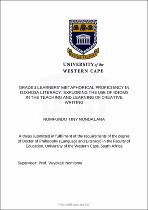| dc.description.abstract | Many South African Foundation Phase learners perform poorly in literacy, especially in reading and writing. The Annual National Assessment (ANA) results show that many Grade 3 learners experience difficulties in reading and in writing sentences from pictures (Howie, Venter, Van Staden, Zimmerman, Long, Scherman & Archer, 2008). The learners also struggle to produce meaningful written sentences, even though they are taught through the medium of their own home languages, including African languages (Department of Basic Education, 2013).
To enrich learners’ language and literacy skills, the Curriculum Assessment Policy Statement (CAPS) encourages the use of figurative and metaphorical language through the teaching of folklore. However, CAPS does not provide explicit guidelines on how folklore ought be taught to enhance learners’ literacy skills. | en_US |

